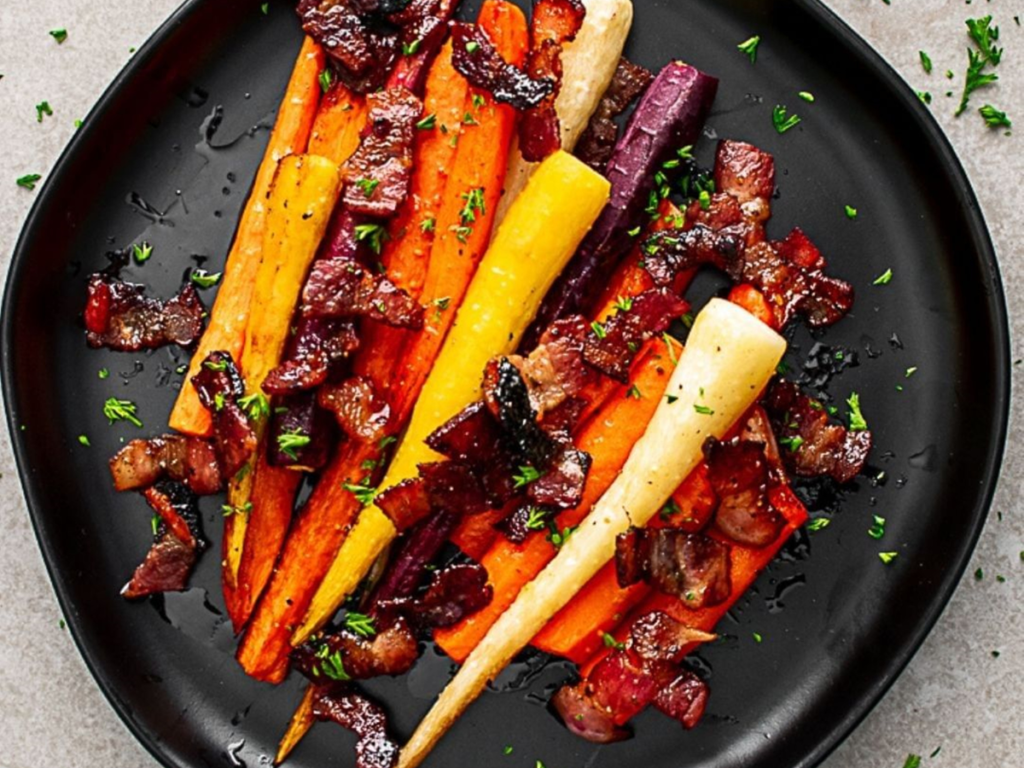
Carrots are a staple in many kitchens around the world, but have you ever wondered, “What enhances carrot flavor?” Whether you’re looking to create a dish that bursts with flavor or simply want to enjoy a sweeter, more vibrant carrot, there are numerous ways to enhance the natural taste of this versatile vegetable.
Understanding Carrot Flavor
Carrots have a naturally sweet and earthy flavor, which can vary significantly depending on several factors. The primary components that affect their flavor include the variety of carrot, the soil they were grown in, and the time of harvest. Freshly harvested carrots typically have a more robust and sweeter taste compared to those that have been stored for a long time.
The Science Behind Carrot Flavor
The flavor of carrots is influenced by several compounds, including sugars, terpenoids, and phenolic compounds. Sugars, primarily sucrose, glucose, and fructose, contribute to the sweetness. Terpenoids provide the earthy and sometimes slightly bitter notes, while phenolic compounds can add complexity and a bit of astringency. The balance of these compounds can vary based on growing conditions, carrot variety, and post-harvest handling.
Factors Affecting Carrot Flavor
Several factors can influence the flavor of carrots, including:
- Soil Quality: Nutrient-rich, well-drained soil tends to produce sweeter carrots. Soil pH and organic matter content also play crucial roles.
- Watering Practices: Consistent watering helps prevent bitterness and promotes sweetness. Overwatering or underwatering can negatively impact flavor.
- Temperature: Carrots grown in cooler temperatures often have higher sugar content. They can develop more intense flavors when exposed to slight frosts.
What Enhances Carrot Flavor?
Roasting carrots is a great way to enhance their sweetness and deepen their flavor. Consider adding a touch of sweetness to your roasted carrots by using ingredients like honey, brown sugar, or even maple syrup. The caramelization that occurs during roasting, combined with the added sweetener, creates a deliciously complex flavor profile.
Selecting the Right Carrots
Not all carrots are created equal. When it comes to flavor, some varieties stand out. For example, Nantes, Chantenay, and Danvers carrots are known for their sweetness and flavor intensity. Choosing the right variety can make a big difference in the taste of your dishes.
Popular Carrot Varieties for Flavor
- Nantes Carrots: Known for their sweet, crisp, and mild flavor, Nantes carrots are ideal for both raw and cooked dishes.
- Chantenay Carrots: These carrots are short, stout, and have a rich, sweet flavor. They are great for roasting and stews.
- Danvers Carrots: With a robust, earthy flavor, Danvers carrots are versatile and excellent for juicing, soups, and stews.
- Imperator Carrots: These long, slender carrots are often found in supermarkets. They have a balanced sweetness and are perfect for snacking and salads.
- Parisian Carrots: Small, round, and exceptionally sweet, Parisian carrots are perfect for gourmet dishes and as a crunchy snack.
Heirloom Carrot Varieties
Heirloom varieties like Purple Dragon, Cosmic Purple, and Atomic Red not only offer unique colors but also distinct flavors. These varieties can add visual appeal and a range of tastes to your dishes.
Harvesting Techniques
The timing of the harvest plays a crucial role in the flavor of carrots. Carrots that are harvested at their peak maturity tend to be sweeter and more flavorful. Overripe carrots can become woody and less appealing, while underripe carrots may lack sweetness.
Optimal Harvesting Time
Carrots usually reach their peak harvest time 60 to 80 days post-planting, contingent on the specific variety. Look for carrots with a vibrant color and a diameter of about 1/2 to 1 inch. For the sweetest flavor, try to harvest carrots after a light frost, as the cold weather can convert some of the starches in the carrot to sugars.
Harvesting Tips
- Loosen the Soil: Use a garden fork or spade to gently loosen the soil around the carrots to avoid breaking them.
- Pull Carefully: Grasp the carrot tops near the base and pull straight up to minimize damage.
- Harvest Gradually: If possible, harvest carrots in stages rather than all at once to enjoy peak flavor over a longer period.
Storage Methods
Proper storage is essential to maintain the flavor of carrots. Carrots should be stored in a cool, humid environment to prevent them from drying out. Storing them in a plastic bag in the refrigerator crisper drawer can help preserve their moisture and sweetness.
Short-Term Storage
For short-term storage, carrots can be kept in the refrigerator for up to two weeks. Place them in a plastic bag or container with a damp paper towel to maintain humidity.
Long-Term Storage
For long-term storage, consider the following methods:
- Root Cellar: Store carrots in a cool, dark, and humid environment such as a root cellar. Place them in layers with sand or sawdust to maintain moisture.
- Blanching and Freezing: Blanch carrots by boiling them for 2-3 minutes, then immediately plunge them into ice water. Drain and pack in airtight containers or freezer bags. Frozen carrots can last up to a year.
- Pickling: Pickling carrots in vinegar and spices can extend their shelf life while adding a tangy flavor.
Preparation Techniques
How you prepare carrots can significantly impact their flavor. Peeling carrots can remove some of the bitterness found in the skin, but it can also strip away some nutrients. Cutting and slicing methods can also affect how the flavor is released during cooking. For example, thinner slices cook faster and can caramelize more easily, enhancing the sweetness.
Peeling vs. Not Peeling
Peeling carrots can remove the bitter outer layer, but leaving the skin on preserves more nutrients and fiber. For organic carrots, washing thoroughly may be sufficient to remove dirt and pesticides.
Cutting Techniques
- Julienne: Thin, matchstick-sized pieces that cook quickly and are great for stir-fries and salads.
- Rondelle: Round slices that are ideal for roasting and steaming.
- Bias Cut: Diagonal slices that increase the surface area for caramelization and flavor absorption.
- Dicing: Small cubes that cook evenly and quickly, perfect for soups and stews.
Cooking Methods to Enhance Flavor

Cooking carrots can bring out their natural sweetness and add depth to their flavor. Here are some cooking methods to consider:
Roasting
Roasting carrots in the oven caramelizes their natural sugars, resulting in a sweeter, more concentrated flavor. Toss them with a little olive oil and your favorite herbs before roasting.
Recipe: Honey-Roasted Carrots
- Ingredients: Carrots, olive oil, honey, thyme, salt, pepper.
- Instructions: Preheat oven to 400°F (200°C). Toss sliced carrots with olive oil, honey, thyme, salt, and pepper. Spread on a baking sheet and roast for 20-25 minutes until tender and caramelized.
Steaming
Steaming carrots preserves their natural flavor and nutrients. It’s a gentle cooking method that keeps the carrots tender-crisp.
Recipe: Steamed Carrots with Lemon Butter
- Ingredients: Carrots, butter, lemon juice, parsley, salt.
- Instructions: Steam sliced carrots until tender, about 5-7 minutes. Toss with melted butter, lemon juice, chopped parsley, and a pinch of salt.
Boiling
Boiling carrots is a quick method, but it can sometimes result in a loss of flavor. Adding a pinch of salt or a splash of vinegar to the boiling water can help enhance their taste.
Recipe: Boiled Carrots with Herbed Butter
- Ingredients: Carrots, butter, mixed herbs (thyme, dill, parsley), salt.
- Instructions: Boil carrots until tender, about 8-10 minutes. Drain and toss with herbed butter and salt.
Grilling
Grilling carrots gives them a smoky flavor that pairs well with their natural sweetness. Brush them with a bit of oil and season them before grilling.
Recipe: Grilled Carrots with Balsamic Glaze
- Ingredients: Carrots, olive oil, balsamic vinegar, honey, salt, pepper.
- Instructions: Preheat grill to medium-high. Coat the carrots with olive oil and sprinkle with salt and pepper. Grill for 10-12 minutes, turning occasionally. Drizzle with a balsamic glaze made from reducing vinegar and honey.
Sautéing
Sautéing carrots in butter or oil brings out their sweetness and adds a rich, savory flavor.
Recipe: Sautéed Carrots with Garlic and Thyme
- Ingredients: Carrots, butter, garlic, thyme, salt, pepper.
- Instructions: Sauté chopped onion and garlic in a pot until translucent. Add sliced carrots and grated ginger, and cook for a few minutes. Add vegetable broth and bring it to a vigorous boil. Simmer until carrots are tender. Blend the soup until smooth. Mix in coconut milk and adjust the seasoning with salt and pepper.
Flavor Pairings
Pairing carrots with the right ingredients can elevate their flavor. Here are some great combinations:
Herbs and Spices
- Thyme: Adds a subtle earthy flavor.
- Rosemary: Provides a strong, aromatic quality.
- Dill: Complements the sweetness with a fresh, slightly tangy taste.
- Cumin: Adds a warm, nutty flavor.
- Coriander: Offers a citrusy, slightly spicy note.
Complementary Vegetables
Carrots pair well with other root vegetables like parsnips, potatoes, and turnips. They also go well with
leafy greens like spinach and kale.
Sauces and Dressings
A simple glaze of honey and mustard, or a drizzle of balsamic reduction, can make carrots irresistible. Creamy dressings like tahini or yogurt-based sauces can also complement their sweetness.
Marinating Carrots
Marinating carrots can infuse them with additional flavors. A simple marinade of olive oil, vinegar, garlic, and herbs can transform their taste. Let the carrots marinate for at least an hour, or overnight for more intense flavor.
Recipe: Marinated Carrot Salad
- Ingredients: Carrots, olive oil, apple cider vinegar, garlic, dill, salt, pepper.
- Instructions: Slice carrots thinly. Whisk together olive oil, vinegar, minced garlic, chopped dill, salt, and pepper. Toss carrots in the marinade and refrigerate for at least 1 hour.
Fermenting Carrots
Fermenting carrots not only enhances their flavor but also adds a tangy, probiotic-rich twist. The fermentation process is simple: submerge sliced carrots in a saltwater brine and let them sit at room temperature for a few days. The result is a crunchy, flavorful snack.
Recipe: Fermented Carrot Sticks
- Ingredients: Carrots, water, salt, garlic, dill.
- Instructions: Dissolve 1 tablespoon of salt in 1 quart of water. Pack carrot sticks, garlic cloves, and dill sprigs into a jar. Pour the brine over the carrots, ensuring they are fully submerged. Cover with a lid and let sit at room temperature for 3-5 days. Store in the refrigerator once fermented.
Using Sweeteners
Natural sweeteners like honey, maple syrup, or agave nectar can enhance the sweetness of carrots without overwhelming their natural flavor. A light drizzle before cooking can caramelize and intensify their sweetness.
Recipe: Maple-Glazed Carrots
- Ingredients: Carrots, maple syrup, butter, cinnamon, salt.
- Instructions: In a saucepan, melt butter and add maple syrup and a pinch of cinnamon. Add sliced carrots and cook over medium heat until tender and glazed, about 10-15 minutes. Season with salt.
Incorporating Fats and Oils
Adding fats and oils to carrots can enhance their flavor and texture. Butter, olive oil, and coconut oil are great options that add richness and depth to the taste of carrots.
Types of Fats and Their Effects
- Butter: Adds a rich, creamy flavor and enhances sweetness.
- Olive Oil: Provides a fruity, slightly peppery note.
- Coconut Oil: Adds a subtle, tropical sweetness.
Enhancing with Acidity
Acidity can balance the sweetness of carrots and add complexity to their flavor. Vinegars like apple cider or balsamic, as well as citrus juices like lemon or orange, can brighten up the taste of carrots.
Recipe: Carrots with Citrus Dressing
- Ingredients: Carrots, lemon juice, orange juice, olive oil, honey, salt, pepper.
- Instructions: Whisk together lemon juice, orange juice, olive oil, and honey. Toss with cooked carrots and season with salt and pepper.
Creative Cooking Ideas

Exploring different recipes can offer new ways to enjoy carrots. Here are some ideas:
Carrot Soufflé
A fluffy, savory dish that highlights the natural sweetness of carrots.
Recipe:
- Ingredients: Carrots, eggs, milk, cheese, butter, flour, salt, pepper.
- Instructions: Preheat oven to 375°F (190°C). Boil and mash carrots. In a saucepan, melt butter and whisk in flour to make a roux. Gradually add milk, stirring until thickened. Remove from heat and stir in cheese. Beat egg yolks and mix with the carrot puree. Fold in beaten egg whites gently. Pour into a greased soufflé dish and bake for 25-30 minutes until puffed and golden.
Carrot and Ginger Soup
A warming, spicy soup that brings out the earthiness of carrots.
Recipe:
- Ingredients: Carrots, ginger, onion, garlic, vegetable broth, coconut milk, salt, pepper.
- Instructions: Sauté chopped onion and garlic in a pot until translucent. Add sliced carrots and grated ginger, and cook for a few minutes. Pour in vegetable broth and bring to a boil. Simmer until carrots are tender. Blend the soup until smooth. Stir in coconut milk and season with salt and pepper.
Moroccan Carrot Salad
A vibrant salad with cumin, coriander, and a touch of honey.
Recipe:
- Ingredients: Carrots, olive oil, lemon juice, honey, cumin, coriander, parsley, salt, pepper.
- Instructions: Grate carrots into a large bowl. Whisk together olive oil, lemon juice, honey, cumin, and coriander. Toss with carrots and chopped parsley. Season with salt and pepper.
Carrot Cake
A classic dessert that showcases the sweetness of carrots in a moist, spiced cake.
Recipe:
- Ingredients: Carrots, flour, sugar, eggs, oil, baking powder, baking soda, cinnamon, nutmeg, cream cheese, butter, powdered sugar, vanilla.
- Instructions: Preheat oven to 350°F (175°C). Mix dry ingredients (flour, baking powder, baking soda, cinnamon, nutmeg) in one bowl. In another bowl, beat eggs, oil, and sugar. Gradually add dry ingredients to wet ingredients. Fold in grated carrots. Pour into a greased cake pan and bake for 30-35 minutes. To make the frosting, blend cream cheese, butter, powdered sugar, and vanilla until creamy and smooth. Spread over cooled cake.
Carrot Juice
A refreshing drink that highlights the natural sweetness of carrots.
Recipe:
- Ingredients: Carrots, orange, ginger, lemon.
- Instructions: Juice carrots, an orange, a small piece of ginger, and a lemon. Mix and serve chilled.
Pickled Carrots
A tangy snack that adds a burst of flavor.
Recipe:
- Ingredients: Carrots, vinegar, water, sugar, salt, garlic, dill.
- Instructions: Slice carrots into sticks. In a saucepan, bring vinegar, water, sugar, and salt to a boil. Pack carrots, garlic, and dill into jars. Pour hot brine over the carrots, leaving some headspace. Seal and refrigerate for at least 24 hours before eating.
Celebrity Chef Tips

Taking inspiration from renowned chefs can also provide great ideas for enhancing carrot flavor. For example, you can try Gordon Ramsay’s carrot recipes, which often include unique ingredient combinations and cooking methods that elevate the humble carrot to gourmet levels.
Conclusion
Enhancing the flavor of carrots is all about choosing the right variety, using proper preparation and cooking techniques, and pairing them with complementary ingredients. Whether you’re roasting, steaming, marinating, or fermenting, there are countless ways to make carrots a star ingredient in your kitchen.
FAQ’s
What brings out the flavor of carrots?
Roasting carrots enhances their natural flavor by caramelizing their sugars, which brings out a richer and deeper taste. Adding a bit of salt or olive oil before roasting can also help intensify their flavor.
What flavors go well with carrots?
Carrots pair well with a variety of flavors including:
- Herbs and spices: Thyme, rosemary, parsley, dill, cumin, coriander, and cinnamon.
- Citrus: Lemon and orange zest or juice can add a refreshing contrast.
- Sweeteners: Honey, maple syrup, and brown sugar can enhance their natural sweetness.
- Savory elements: Garlic, onions, and ginger add depth to carrot dishes.
- Nuts and seeds: Almonds, walnuts, and sesame seeds provide a nice crunch and complement the sweetness of carrots.
What makes carrots taste good?
Carrots taste good when they are cooked to bring out their natural sweetness and combined with complementary flavors. Methods like roasting, glazing with honey or brown sugar, and seasoning with herbs and spices can enhance their taste. Using fresh, high-quality carrots also makes a big difference.
What brings out the sweetness in carrots?
To bring out the sweetness in carrots, roasting is a great method. The high heat caramelizes the natural sugars, making them sweeter. Adding a touch of honey or brown sugar during cooking can also enhance their sweetness. Additionally, cooking carrots with a bit of butter can help to amplify their natural sugars.
